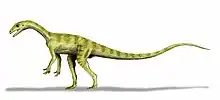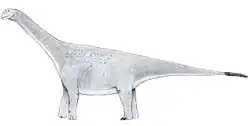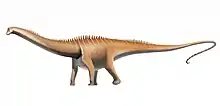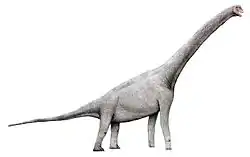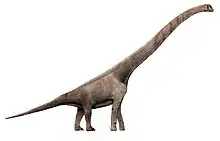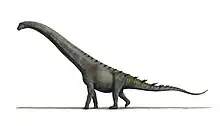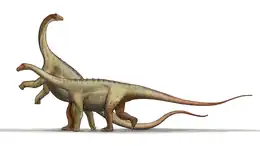| Jiangshanosaurus Temporal range: Late Cretaceous, ~ | |
|---|---|
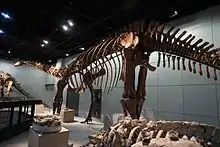 | |
| Skeletal mount | |
| Scientific classification | |
| Domain: | Eukaryota |
| Kingdom: | Animalia |
| Phylum: | Chordata |
| Clade: | Dinosauria |
| Clade: | Saurischia |
| Clade: | †Sauropodomorpha |
| Clade: | †Sauropoda |
| Clade: | †Macronaria |
| Clade: | †Titanosauriformes |
| Genus: | †Jiangshanosaurus |
| Species: | †J. lixianensis |
| Binomial name | |
| †Jiangshanosaurus lixianensis Tang et al., 2001 | |
Jiangshanosaurus is a genus of herbivorous titanosauriform sauropod dinosaur that lived in China approximately 92-88 million years ago,[1] during the Turonian-Coniacian stage of the Late Cretaceous.
Discovery and naming
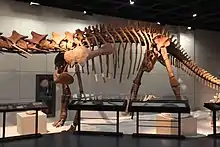
In 1977 and 1978 a sauropod skeleton was excavated by paleontologists Wei Feng, Wu Weitang and Kang Ximin in the Jinhua Formation of Lixian Village, Jiangshan county, in the eastern Chinese province of Zhejiang.
The type and only named species, Jiangshanosaurus lixianensis, was formally described by Tang Feng, Kang, Jin Xingsheng, Wei and Wu in 2001. The holotype, ZNM M1322, of J. lixianensis includes elements of the left shoulder, five back vertebrae, three tail vertebrae, the pubic bones, the ischia, and a left femur.[2] The genus name refers to Jiangshan County; the specific name refers to the village of Lixian.
In 2019, Philip Mannion e.a. redescribed the holotype.[3]
Description
Size
According to paleontologist Thomas R. Holtz Jr. the exact size of this sauropod cannot be determined.[4] Gregory S. Paul estimated its length at eleven meters and its weight at 2500 kg.[5]
Distinguishing traits
In 2019, Mannion e.a. indicated two distinguishing traits. They were autapomorphies, unique derived characters. In the vertebrae positioned at the transition between the tail base and the middle tail, the lower ends of the laminae spinoprezygapophyseales, the ridges running from the neural spine towards the front articulation processes, are placed to the inside of these processes, the prezygapophyses, instead of touching them. The lower shaft of the ischium ends in a small process, formed as a hook, on its top outer side.[3]
Phylogeny
Although Jiangshanosaurus initially defied precise placement within Titanosauria, in 2017 paper considered it to be outside Lithostrotia.[6]
According to the 2019 study, Jiangshanosaurus was placed in the Somphospondyli in a basal position, outside the Titanosauria.[3]
References
- ↑ Xi, Dangpeng; Wan, Xiaoqiao; Li, Guobiao; Li, Gang (2018-09-19). "Cretaceous integrative stratigraphy and timescale of China". Science China Earth Sciences. 62 (1): 256–286. doi:10.1007/s11430-017-9262-y. ISSN 1674-7313.
- ↑ Feng Tang, Xi-Min Kang, Xing-Sheng Jin, Feng Wei, Wei-Tang Wu (2001) "A New Sauropod Dinosaur of Cretaceous From Jiangshan, Zhejiang Province" in: Vertebrata PalAsiatica. Bd. 39, Nr. 4, pp. 272–281.
- 1 2 3 Philip D. Mannion; Paul Upchurch; Xingsheng Jin; Wenjie Zheng. 2019. "New information on the Cretaceous sauropod dinosaurs of Zhejiang Province, China: impact on Laurasian titanosauriform phylogeny and biogeography". Royal Society Open Science. 6(8): Article ID 191057
- ↑ Holtz, Thomas R. Jr.; Rey, Luis V. (2007). Dinosaurs (, p. 34). New York: Random House. ISBN 978-0-375-82419-7.
- ↑ Paul, G. S. (2016). The Princeton Field Guide to Dinosaurs, 2nd Edition. Princeton University Press, p. 234.
- ↑ Averianov, Alexander; Sues, Hans-Dieter (2017). "Review of Cretaceous sauropod dinosaurs from Central Asia". Cretaceous Research. 69: 184. doi:10.1016/j.cretres.2016.09.006.
